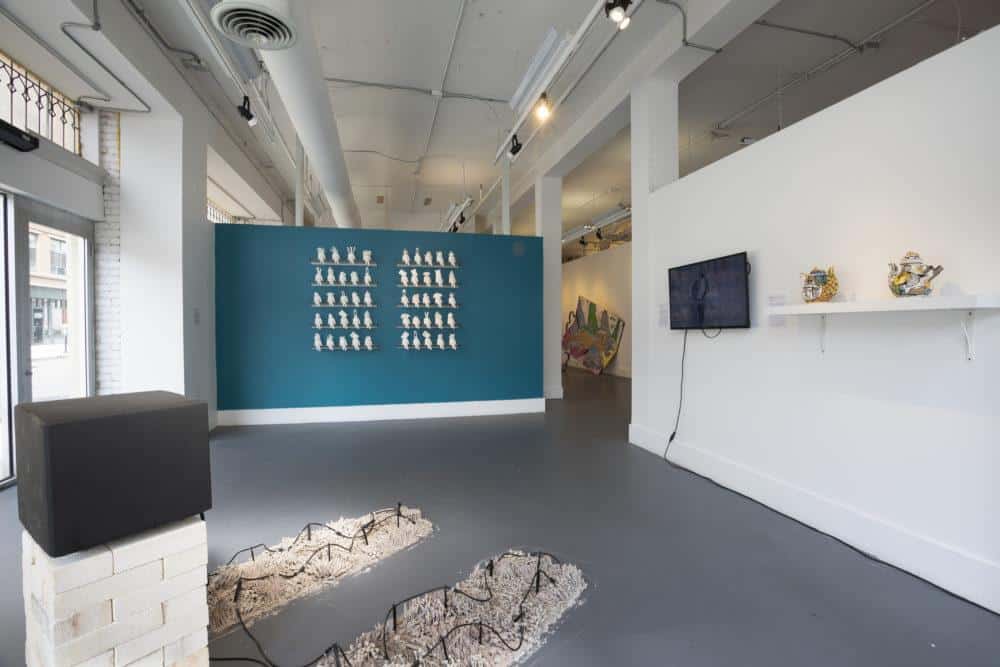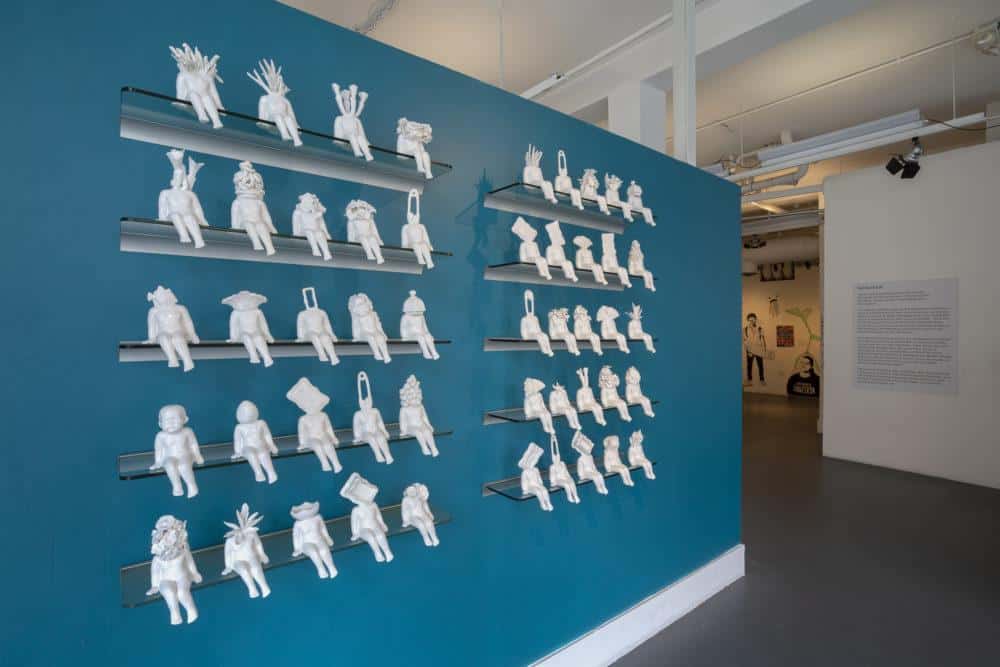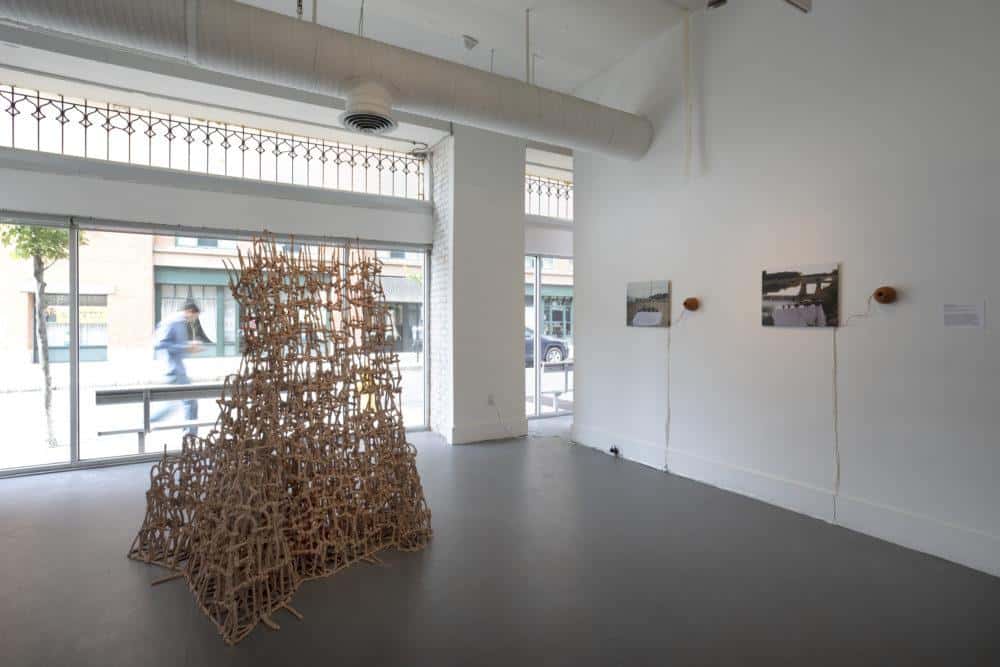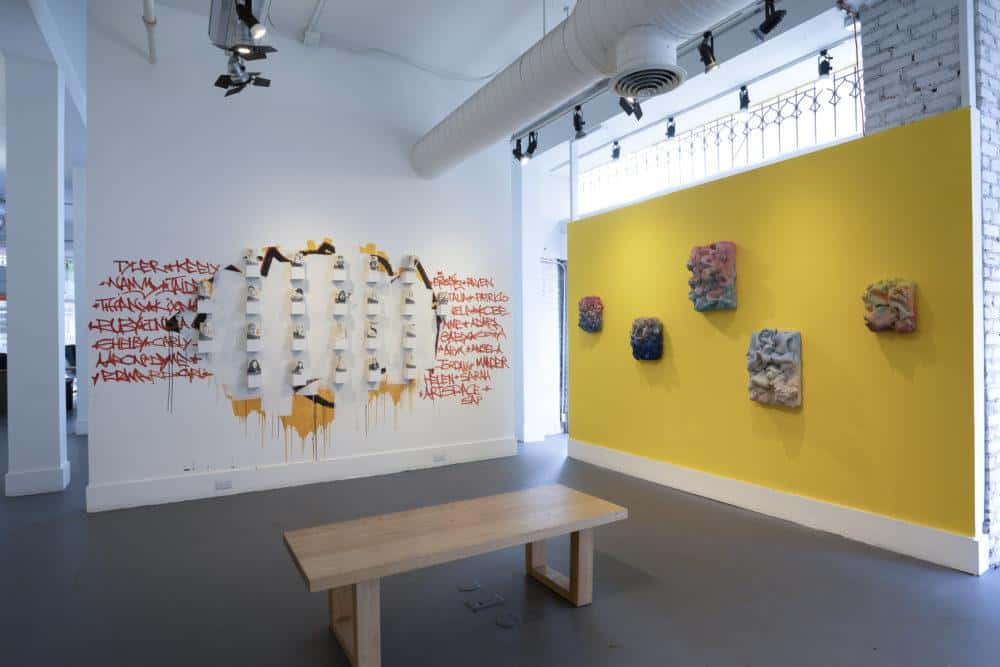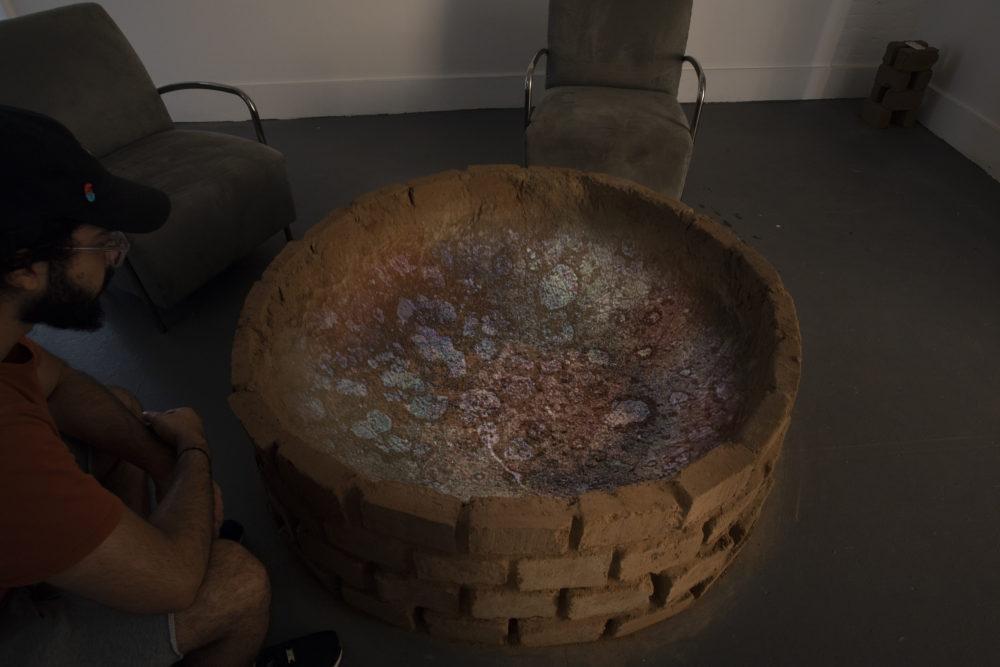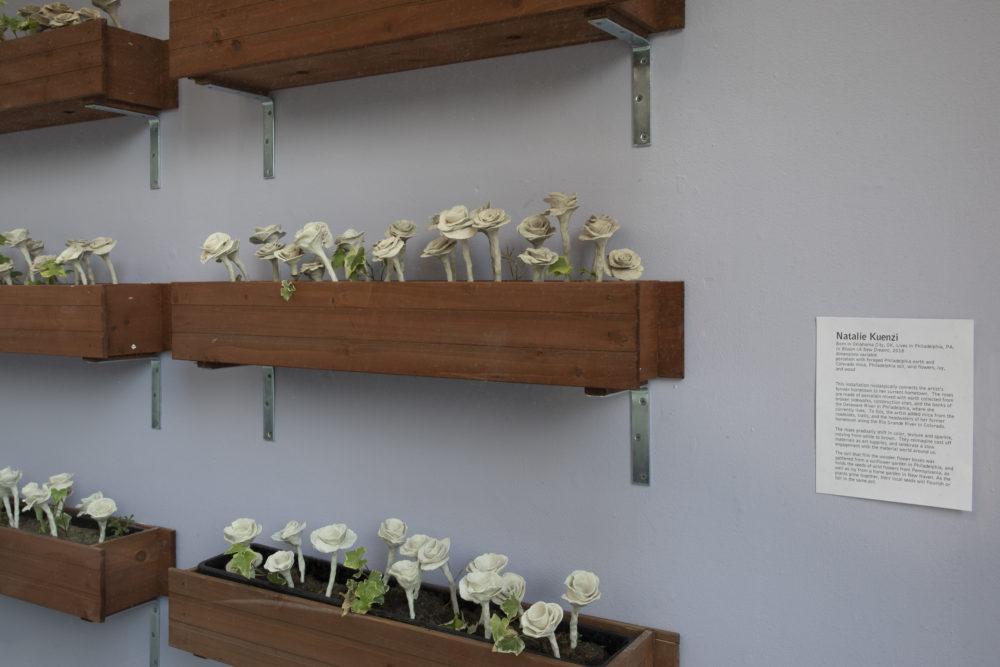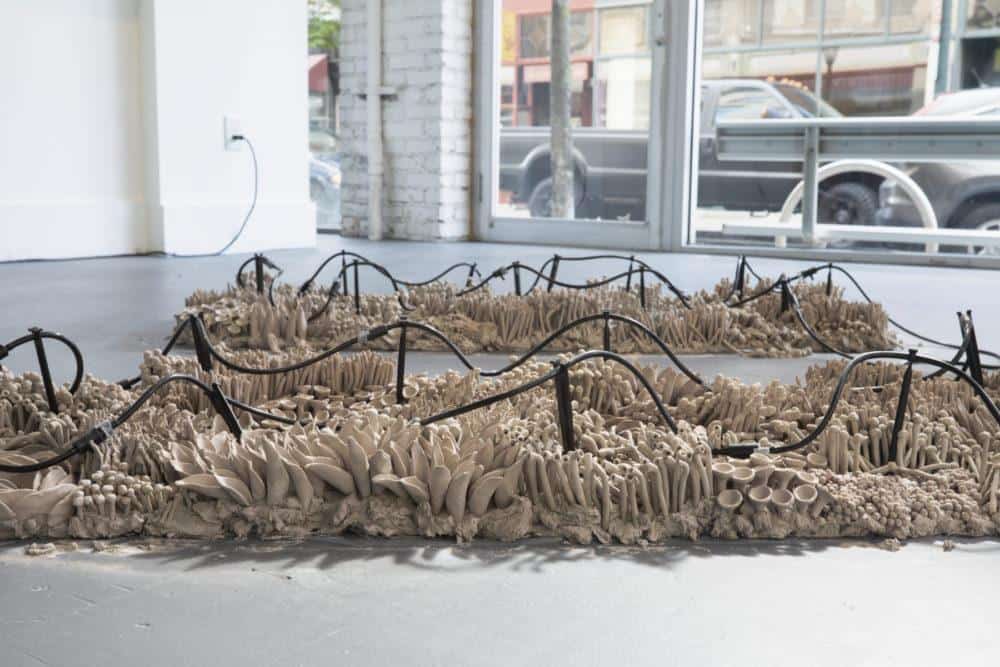
Ball Snake Ball
Curated by Sarah Fritchey and Roberto Lugo
July 27—September 8, 2018
Artists Include: Morel Doucet, Rachel Eng, Shannon Goff, Natalie Kuenzi, Roberto Lugo, and Ruben Olguin.
installation view of Ball Snake Ball, 2018. Photo credit by Jessica Smolinski.
Opening Reception: Friday, July 27, 5-7pm
Ball Snake Ball presents objects and installations by a group of emerging and mid-career artists, based in cities and small towns across the U.S., who use clay to confront issues of environmental justice specific to their communities. Many of the artists incorporate locally sourced clay in their pieces to connect the material component of their work to site. The works explore local, regional and indigenous histories of land and water use, occupation, access, and urban development. Within these studies, questions of inheritance and identity emerge, specifically, who has the power to occupy, use and develop our natural environments.
The title of the exhibition references the process by which an individual might dig and process clay, straight from the ground. Approximately 80 percent of the earth’s land surface contains clay. As a rule of thumb, if clay pulled from the ground can be hand rolled into a ball-like shape, and then a snake, and back into a ball again, it passes the test for optimal malleability.
Artists Include: Morel Doucet (Miami, FL), Rachel Eng (Carlisle, PA), Shannon Goff (Detroit, MI), Natalie Kuenzi (Philadelphia, PA), Roberto Lugo (Philadelphia, PA), and Ruben Olguin (Roswell, NM).
On September 8, 2018, Artspace presented “Paying Homage: Soil and Site,” a free, full-day interdisciplinary summit to promote dialogue on the interplay of environmentalism, social justice, the arts, and community identity. It responded to the companion exhibition Ball Snake Ball and the artwork created by participants in Artspace’s 18th annual Summer Apprenticeship Program, a partnership with Vital New Voices, by assembling scholars, activists, educators, and civic leaders working on environmental justice issues to explore the politics of our basic environmental needs and the consequences of historical environmental racism on our local communities, as well as the role of the land itself as a lasting monument to these injustices and others.
Learn more about the conference Paying Homage: Soil and Site Environmental Justice Summit, including program and speakers in this program book.
Morel Doucet’s work, White Noise, Let the choir sing a magnified silence (50 Affirmation) features 50 porcelain Venus figures, with alternating organic elements and commodities for heads. The work serves as a commentary on the development of Miami’s coastal regions, the development of which, while it brings in tourism, exacerbates the problems Miami faces such as sea-level rise and inflated costs of living. His other work, Cells/Follicles/Biota Series is comprised of five spray painted porcelain casts that reference what a coral reef might look like under a microscope. Born in Haiti, Doucet brings attention to the coral reef bleaching brought on by climate change.
Rachel Eng’s featured works, Rehydration and Growth IV use unfired clay, shaped to look like fungus to examine the relationships between human systems and biological systems and the decay thereof. While Growth IV places the installation outdoors, where it contemplates the ability of certain organisms to take root and grow in seemingly uninhabitable places, Rehydration rests indoors, where a watering system periodically turns on and off. As it is wetted and dries, its potential is altered, presenting a meditation of water access, storage, and use.
Shannon Goff’s Raze Raise is a tower of unfired clay snakes, pressed together to form a dense network that reaches almost 6 feet tall. While at first glance, it seems random, its base, almost hidden under the mass of clay that grows from it, traces the rivers, wetlands, roads, and highways of the city of New Haven. A Detroit native, Goff saw first-hand the impact of her city’s economic downfall and her work explores the relationship between growth and progress.
In Bloom (A New Dream) by Natalie Kuenzi is a work that connects the various places that have been a part of Kuenzi’s life. Three rows of two flower boxes hang in front of a window, each row containing differently-colored porcelain roses whose materials were sourced from both the Delaware River in Philadelphia and the Rio Grande River in Colorado. The flowers are planted in Philadelphia soil along with New Haven ivy, bringing places together through the use of cast off materials. Kuenzi’s other work on display, We All Have the Sky Series comprises of several different sculptures composed of materials differing in longevity. Terra cotta, hand dug clay, cardboard, porcelain, and other materials make up her popcorn or cloud-shaped works, which both lean and hover mounted against the white wall.
Roberto Lugo, our latest artist to mentor our 2018 group of student apprentices (SAP), has four works on display: Ghetto is Re·source·ful, Winfred and I, Stunting: Tupac and Dre, and Those Who Taught Me. An activist, ceramicist, and rapper/poet from Philadelphia, Lugo’s work is the linchpin between all three exhibitions on view at Artspace. Ghetto is a video following Lugo in his process clay-making process as he narrates stories from his youth. Two of his other featured works are teapots shaped in a Victorian era aesthetic. While Winfred pays homage to Winfred Rembert, an African American artist friend of Lugo, Stunting brings together the two rappers Tupac Shakur and Dr. Dre in a contemplation of how a stunting rapper might stunt an entire community. Those Who Taught Me is a series of 19 clay cups created during the time Lugo spend mentoring the SAP program’s apprentices, each featuring a hand-drawn portrait of one of the 19 students in the program. They commemorate the time he spent with the students, and the students will be able to take their cup home at the end of the show.
For Angostura Series, Ruben Olguin mounted two adobe clay bowls formed to amplify the noise of surrounding road and air traffic as recorded electronically. Photographs mounted beside both bowls document the artist playing back these recordings at sites of indigenous displacement. Olguin’s other featured works, Fractured: Broken Landscapes and Traces Series make use of clay bowls and video projection to explore historical erasure and recovering those histories. Fractured is a large four-foot bowl within which the video depiction of raw clay and water drips onto a canvas, resulting in random formations and destructions of streams and pools, much like how America’s landscape was naturally formed before it created the basis for how society’s infrastructure developed. For Traces Series, Olguin uses projectors used in planetariums to remap traditional Nambé Pueblo motifs, previously distorted by 2D imaging, onto contemporary vessels made from hand dug micaceous clay.
